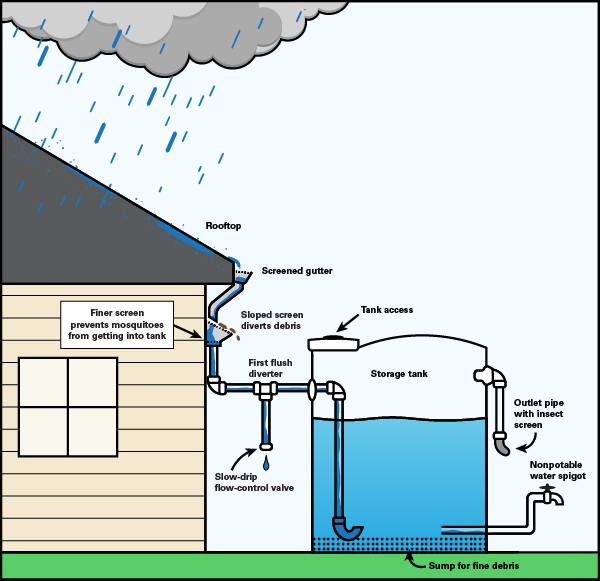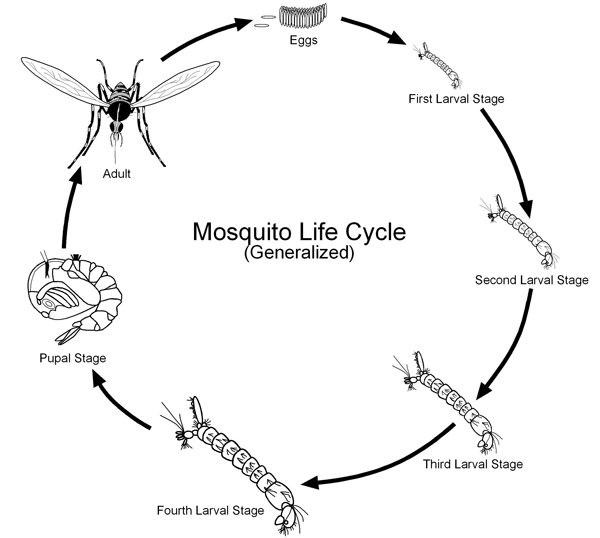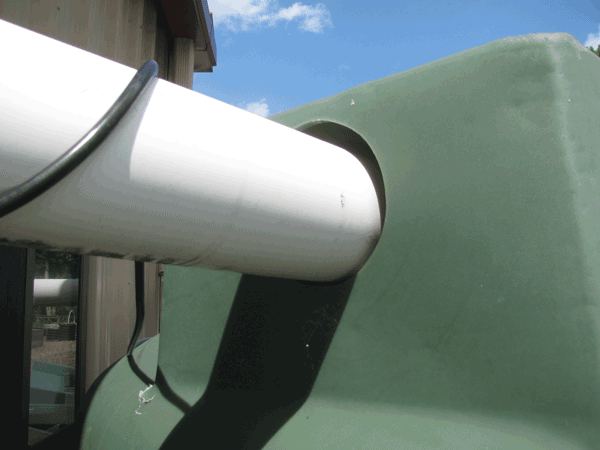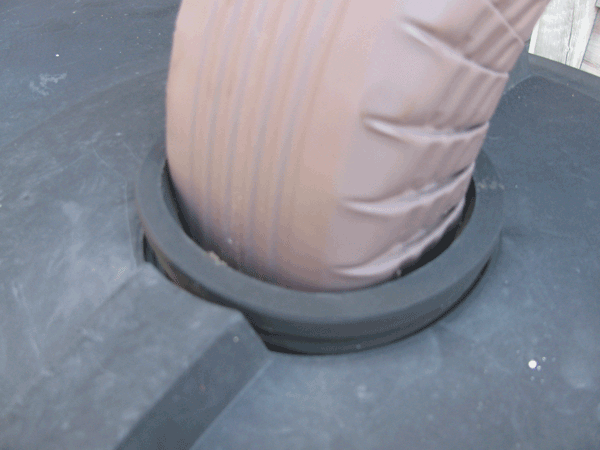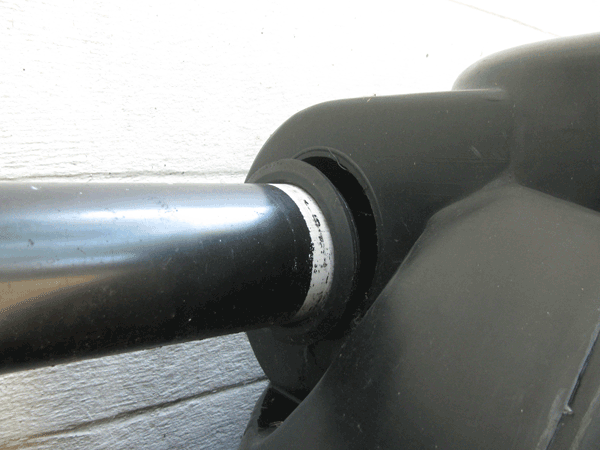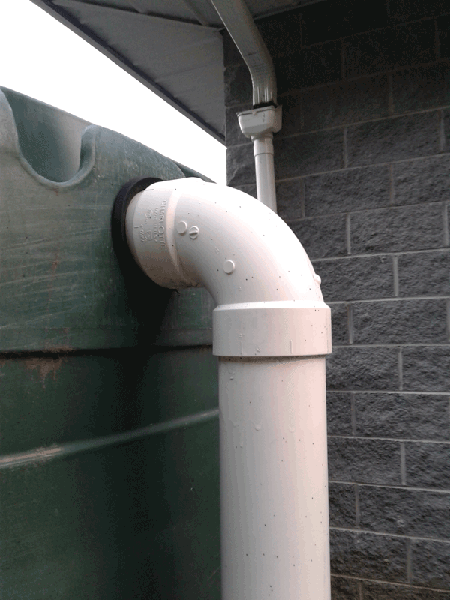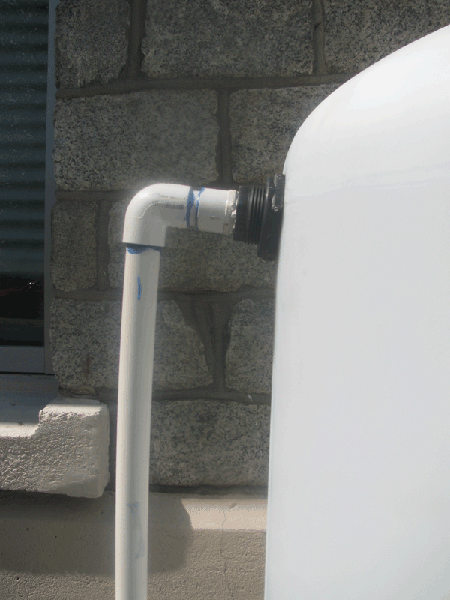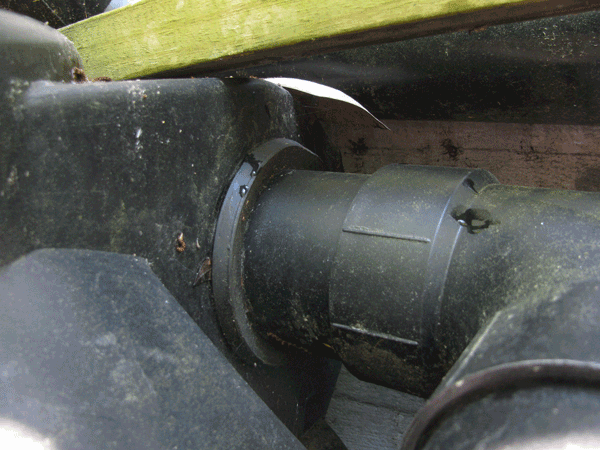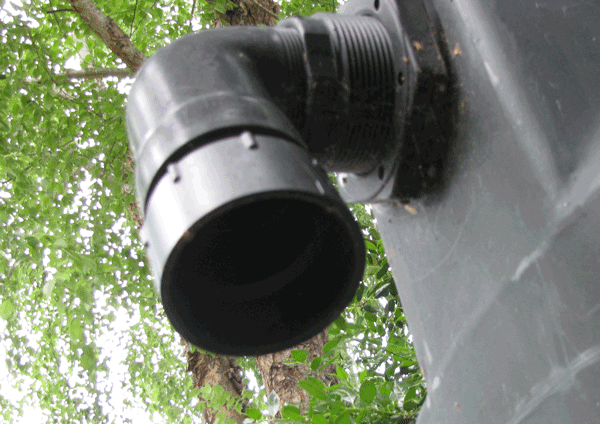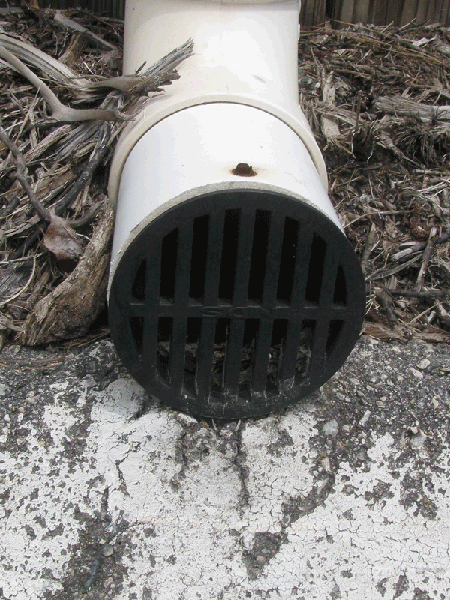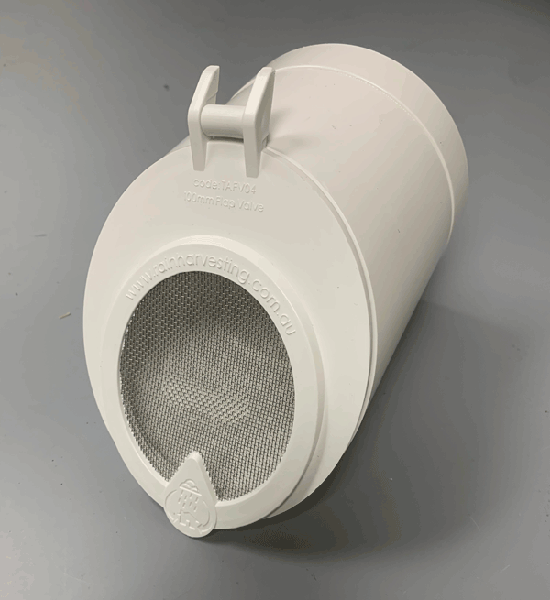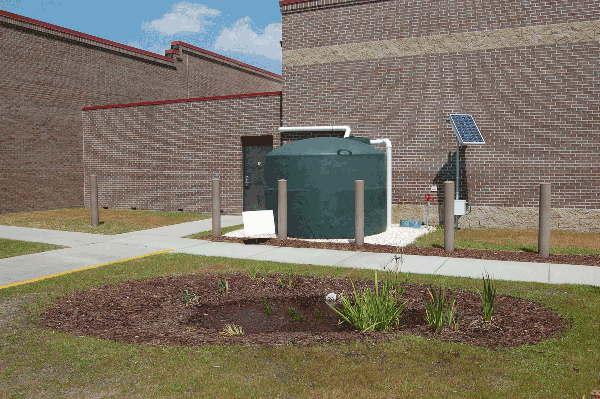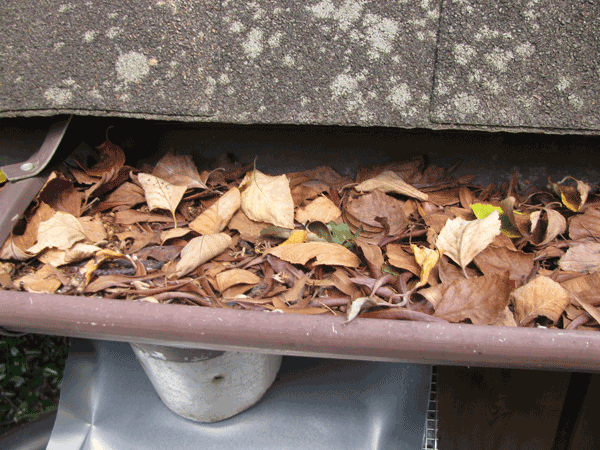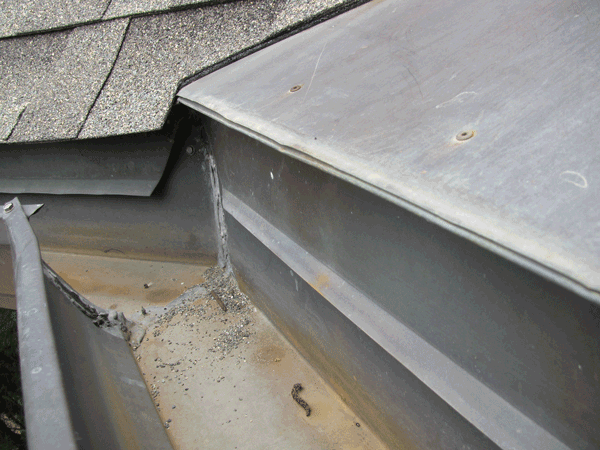A stormwater control measure (SCM) is a practice that combats problems caused by excessive impermeable surfaces (such as flooding, property loss due to erosive flows, and impacts to fishing and shellfishing). SCMs are required by law in North Carolina and other states. One common SCM is the rainwater harvesting (RWH) system. While SCMs provide many benefits, one of the principal concerns is whether they create conditions that harbor mosquitoes. The concern is valid because all SCMs hold water at least some of the time and mosquitoes mature in standing water. This factsheet is a complement to the NC State Extension publication Mosquito Control for Stormwater Facilities with a specific emphasis on RWH systems. It includes a review of design and maintenance features that minimize mosquito populations.
Rainwater Harvesting Systems
Rainwater harvesting (RWH) systems collect runoff from hard surfaces, usually rooftops, and store it for later use. In the United States, these systems predominantly consist of piping to deliver runoff from a rooftop to a storage tank; a covered storage container; an overflow pipe to allow water to exit a storage tank when it is full; and some method of extraction (a pump or a gravity-fed hose or spigot) (Figure 1). Stored rainwater can be used for nonpotable purposes, such as irrigation and car washing. With proper treatment, stored rainwater may also become a potable water source for bathing, cooking, and drinking. RWH systems are unique among SCMs in that they are both a water conservation practice (they provide a secondary source of water) and a stormwater management tool (they reduce the volume and rate of stormwater runoff leaving a hard surface). Thus, RWH systems are valuable tools that contribute to two important environmental goals: conserving potable water that is customarily provided by utilities and mitigating stormwater runoff. For more information on designing RWH systems, see the NC State Extension publications Urban Waterways: Rainwater Harvesting Guidance for Homeowners (AG 588-11) and Urban Waterways: Choosing a Pump for Rainwater Harvesting (AG 588-08).
In North Carolina and other places with humid climates, water supply sources are typically plentiful and prolonged drought is unusual. Periodically, there are exceptions. In 2007 and 2008, for example, North Carolina experienced a severe, persistent drought during which water supplies dwindled and many municipalities had to implement mandatory water restrictions. During droughts, RWH systems become popular among residents because they provide a secondary source of water not subject to state or local water restrictions. When the drought ends and rainfall is abundant again, however, these systems are often underutilized, resulting in a stockpile of standing water. Even in frequently used RWH systems, a small amount of water always remains present in the bottom of the tank due to the tank design. It is recommended that the outlet to extract water always be 1 to 2 inches above the bottom of the tank because a thin layer of accumulated sediment and organic matter settles there. This water can be a prime environment for mosquitoes.
Why Mosquitoes Matter
All breeding mosquitoes have two common requirements: water and oxygen. They need water to complete their life cycle (Figure 2a), and the larval and pupal stages must breathe air. An adult female mosquito will lay her eggs in standing water, and these eggs usually hatch within 24 to 48 hours. The quantity of water does not have to be significant; even a small amount can provide an attractive location for a mosquito to lay eggs. The larvae that emerge from the eggs — often called “wrigglers” because they can be seen wriggling within the pool of water — progress through a series of growth stages over the next seven to ten days (Figure 2b). The mosquito larvae feed off organic material on the bottom of the water pool and swim to the surface to breathe oxygen. Larvae then enter a pupal stage. Adult mosquitoes emerge from the pupae three to four days later.
North Carolina is home to approximately 65 species of mosquitoes. These mosquitoes are categorized as either container breeders or swamp/floodwater breeders. Swamp/floodwater species can breed in transient water sources, such as flooded areas and ditches, or permanent water sources, such as swamps or wetlands. The eggs of these species can withstand — and often require — dry periods that desiccate the eggs before they hatch. Container-breeding species can be found in natural settings, such as tree holes and water-holding plants, or in artificial settings, such as tires or other containers. Eggs of some container breeders can also withstand prolonged dry periods.
Mosquitoes are not only a nuisance, but they can also transmit diseases to humans, including West Nile virus, eastern equine encephalitis, and Zika virus. Individual species are associated with certain diseases; not all mosquitoes are able to transmit all viruses, and some do not transmit any at all. Unfortunately, one of the most common container-breeding mosquitoes in North Carolina, the Aedes albopictus, can be a vector (carrier) of dengue, eastern equine encephalitis, Jamestown Canyon, LaCrosse encephalitis, and West Nile viruses (Reed et al. 2018). It is important to minimize suitable breeding habitats to mitigate disease transmission and the overall threat to public health.
RWH System and Mosquitoes: Is There a Problem?
Although the geographic distribution of various mosquito species has been well researched, only a few studies have directly investigated the relationship between mosquitoes and RWH systems.
In Australia, due to persistent recent droughts and increasingly limited water supplies, many Australian municipalities encourage or require RWH as a means of conserving potable water supplies by substituting nonpotable harvested rainwater when the use of potable water is not necessary. This increased implementation of RWH, combined with the presence of the Aedes aegypti mosquito (which is a known transmitter of disease agents that include dengue fever, Zika, yellow fever, and chikungunya), has prompted an interest in investigating the role of RWH tanks in the breeding and proliferation of mosquitoes. A majority of this research has been conducted in Australia, with one study taking place in the southeastern United States.
Tun-Lin et al. (1995) assessed the presence of Aedes aegypti larvae in water-holding containers located on 1,349 properties in three localities within Queensland, Australia. In two of the three surveyed localities, RWH storage tanks were found to be key breeding containers, meaning that they contributed significantly to the Aedes aegypti population. In one jurisdiction, rainwater tanks represented only 13.5% of the total containers found to contain Aedes aegypti larvae, but contributed 60% of the total number of larvae found. In another locality, rainwater tanks represented only 30% of the containers harboring Aedes aegypti larvae, but were responsible for 63% of the total number of larvae found. The study concluded that prioritizing rainwater tanks as part of mosquito control efforts would be a cost-effective strategy.
In 2016, the characteristics of 297 RWH systems were extensively surveyed in Melbourne, Australia, for the presence of mosquito larvae (Moglia et al. 2016). Of the surveyed tanks, 63 (21%) had either mosquito larvae or adults inside. This study focused on design and installation aspects of the RWH systems and how they correlated with the presence of mosquitoes. It was reported that 46% of tanks without inlet screens and 33% of tanks with inlet screens in poor condition contained mosquito larvae, compared to only 15% of tanks with screens in good condition. The observations illustrated the importance of adequately screened inlets in rainwater tanks, but also indicated that even when screens are present, mosquito larvae may still live in the tank. The presence of mosquitoes in adequately screened tanks was likely due to other openings in the system (maybe caused by ill-fitting screens or seals or physical damage to the body of the tank) that allowed mosquitoes to access the rainwater tank. The adequacy of the overflow design also influenced the presence of mosquito larvae. Of systems that had adequate overflow pipes (for draining water away from the tank) and effective screening to seal and prevent mosquitoes from entering the tank, only 18% contained mosquito larvae, whereas 44% of systems with inadequate overflow systems contained larvae. Without a doubt, the lowest incidence of mosquito larvae occurred when both the inlet was screened AND the overflow setup was adequate and effective — only 4% of systems meeting these criteria contained mosquito larvae.
In 2017, an unpublished study by the authors of this publication was conducted to determine the prevalence of mosquitoes in RWH systems in the southeastern United States. A total of 64 rainwater storage tanks (cisterns) were sampled at 42 unique sites throughout North Carolina and Virginia. Each site was visited once to sample rainwater storage tanks for mosquito larvae and collect data regarding system design, maintenance, and environmental characteristics, all of which might influence the presence and abundance of mosquito larvae within a system.
Of the 64 rainwater tanks sampled for the study, 30 (47%) contained mosquito larvae (Figure 3). Of the 30 systems in which mosquitoes were found, the number of larvae found per tank ranged from 1 to 451, with a median of 13 mosquitoes per tank. The majority of the mosquitoes found within the systems were Aedes albopictus (67%), followed by Culex hybrid (13%), Aedes triseriatus (1.4%), Aedes japonicus (0.7%), and Toxorhynchites rutilus (<0.1%). (The remaining specimens were unable to be identified.)
Table 1 summarizes the species of mosquitoes found in these systems along with the viruses or diseases for which they may serve as a vector. Four of the five identified species are capable of spreading mosquito-borne illnesses. In fact, all of the mosquito-borne diseases that are currently a threat in Virginia and North Carolina can be transmitted by four of the species found in this study.
| Mosquito Species | Affiliated Diseases/Viruses |
|---|---|
| Aedes albopictus
|
Eastern equine encephalitis, Zika virus, LaCrosse encephalitis, West Nile virus
|
| Aedes japonicus
|
West Nile virus, LaCrosse encephalitis
|
| Aedes triseriatus
|
LaCrosse encephalitis
|
| Culex hybrid
|
St. Louis encephalitis, West Nile virus
|
| Toxorhynchites rutilus
|
N/A (not a vector mosquito)
|
The 2017 study identified several characteristics of RWH systems that were associated with the presence of mosquitoes within the water storage tank. The presence of unscreened entry points into the tank, such as where there are gaps due to lack of a fitted gasket (Figure 4a), an improperly sized gasket (Figure 4b), or a disconnected gasket (Figure 4c), was the most significant factor contributing to larvae within the tank; 32 of the surveyed systems contained unscreened entry points and, of those systems, 20 (63%) contained mosquito larvae. Another factor affecting larvae presence was the amount of shade surrounding the RWH system; the presence of surrounding vegetation and foliage positively correlated with the presence of mosquito larvae in systems. Of the 64 systems sampled, 20 had heavy shading/foliage and 15 of those (75%) contained mosquito larvae. Forty-four of the sampled systems had moderate or heavy shading/foliage, 23 (52%) of which contained mosquito larvae. A third factor influencing the presence of mosquito larvae was the amount of debris present in the gutters delivering water to the tank. Ten of the surveyed RWH systems were connected to gutters containing large amounts of debris (leaves, sticks, and organic matter); eight of those, or 80%, had mosquito larvae in the tank. While existence of any of the previously described situations does not guarantee that larvae will be present within a given system, the more characteristics that are present that favor mosquitoes, the higher the likelihood there will be larvae in the tank.
Methods of Mosquito Control
While RWH systems can serve as a breeding ground for mosquitoes, they don’t have to. These systems can be designed and managed in ways that significantly reduce the likelihood of mosquitoes accessing and breeding in the water storage tank.
System Design
Several key design parameters of RWH systems can limit the potential for nuisance populations of mosquitoes in a tank. The most effective method of controlling mosquitoes in RWH systems is preventing adults from entering the tank by screening or sealing all potential entry points. Entry points include inflow and overflow pipes, tank vents, and gaps around the tank lid or where pipes enter or exit the tank. Figure 5a shows how a tightly fitted gasket between the pipe and side of tank can prevent holes or gaps; Figure 5b shows an example of how a tight bulkhead fitting between the pipe and side of tank can create proper sealing. Figure 5c shows an example of a crack due to an improperly fitted gasket.
Despite the screening of entry points being a widespread design recommendation, a large percentage of systems still contain portals where mosquitoes can access the tank (Figure 6a). For example, none of the 64 systems surveyed in North Carolina and Virginia included a method of screening or sealing the overflow pipe, and 32 (47%) contained unscreened inlets that allowed mosquitoes to fly into and out of the storage tank. The screens used for overflow pipes and prefiltration devices should be corrosion resistant. The mesh should be finer than 1/16 inch (1,500 microns); mosquitoes will be able to penetrate larger openings (Figure 6b). Moreover, screens should be in good condition, without holes or cuts, and cover the entire opening. Gaps can be filled with an outdoor, waterproof caulk or tightly covered with sealing tape designed for outdoor use. An alternative to screening the overflow pipe is to install a flap valve (Figure 6c) that is specially designed for RWH systems. These flap valves contain a screened flap that remains closed when there is no overflow but opens when overflow occurs to prevent water from backing up the overflow pipe.
The 2016 Australian study concluded that the most effective tank design for mosquito control was one in which the inlet was screened and the overflow setup was effectively screened and adequately drained the flow during intense rain events. Thus, in addition to being screened, overflow pipes should also be designed to convey water to an area that is well drained, as standing water around the systems can also be a breeding ground for mosquitoes. Figure 7a shows an example of where the overflow pipe has led to a standing water situation; Figure 7b shows an overflow pipe properly leading to a curb-and-gutter feeding a stormwater system; Figure 7c shows a bioretention area for receiving overflow. The North Carolina Department of Environmental Quality requires RWH systems to direct overflow water to an existing stormwater drain, a nearby SCM that facilitates infiltration, or an area that can convey or infiltrate the water without causing erosion or recurring, prolonged wet areas.
Locating the Tank
Mosquito control is just one factor to consider when choosing where to site your RWH tank. It is important to choose a site where stored water will be kept as cool as possible. What’s good for mosquito control (such as avoiding placement of an RWH system under overhanging vegetation) is bad for thermal pollution. Overhanging vegetation will shade the system but will increase the amount of debris conveyed to the gutters and, ultimately, the rainwater tank. The accumulation of gutter debris (Figure 8a) provides an attractive environment for mosquitoes (within the gutter) and can influence the water quality of stored rainwater. Furthermore, excess debris will increase the frequency with which prefiltration devices such as first-flush diverters and inlet screens need to be inspected and maintained. When used in locations where mosquito populations are a concern, rainwater tanks ideally should be sited where they will receive runoff from rooftops in locations with minimal overhanging trees.
Routine Maintenance
RWH systems must be adequately maintained to ensure optimal function and prevent mosquito proliferation. Routinely examine all screens and seals to ensure that they are intact. Clear any accumulated debris from screens and periodically remove and wash them to remove fine grit and organic film. When cracks or holes are discovered, replace screens and remove and reapply sealants. Check gutters routinely and remove any accumulated debris and organic matter (Figure 8b). In locations with overhanging vegetation, check gutters and prefiltration devices often to prevent the buildup of debris. Installing gutter screens (Figure 8c) can prevent the buildup of debris in gutters and reduce the necessity of gutter and prefiltration maintenance.
Other Methods of Control
If a system was designed in a way that prevents the previously mentioned system design recommendations from being implemented, biological or chemical controls can be used to control mosquito populations. Many different products are available to property owners and maintenance professionals to prevent mosquitoes from breeding in standing water. Most of these are available from local home improvement stores or online retailers. For RWH systems, the ideal product is one that sinks when placed in water. Because most systems are designed such that the overflow pipe draws water from the top of the water surface, products that float will be flushed out of the tank when it overflows. When selecting a product, carefully read the label for instructions on rate and frequency of application and the safety of the product for pets and people. If stored rainwater is being used for activities that will not involve animals (be sure to consider possible unintentional exposure), then the products that include safety warnings for animal consumption would be appropriate to use. A product with s-methoprene as an active ingredient is a good choice, as this insect growth regulator is specific to mosquitoes and does not harm vertebrates; therefore, it is considered safe for people, livestock, and fish. Products with spinosad as the active ingredient are effective but should not be used if water will be consumed by people, livestock, or other animals.
In addition to using biological controls in the RWH tank, follow the standard recommendations for controlling mosquito populations outside the tank. Remove and empty all artificial containers that hold water in which mosquitoes can breed, and eliminate any other sources of standing water (natural or artificial) on the property. Low-lying wet areas can alternatively be turned into mosquito-resistant rain gardens and wetland gardens. Reducing mosquito populations in the vicinity will potentially reduce the number of mosquitoes that can access the tank.
What Doesn’t Work?
Adding bleach to stored rainwater is not an effective strategy for mosquito control; when applied in recommended amounts to kill waterborne pathogens, the concentration may or may not be enough to kill mosquito larvae. Furthermore, bleach dissipates quickly, making it largely ineffective for long-term control.
Frequently draining the tank is not an effective control strategy because of the small amount of water that sits in the bottom of a properly designed tank; that 1 to 2 inches of water is adequate for mosquito breeding. Even in tanks designed to periodically drain this water from the bottom, the eggs of many mosquito species can be dried out multiple times and still successfully hatch.
Summary
Rainwater harvesting is a valuable practice in conserving potable water and mitigating the impacts of urban stormwater, but it is imperative that RWH systems do not threaten public health and safety by harboring mosquitoes. Several simple actions can ensure that a RWH system does not contribute to the breeding of mosquitoes:
- Screen or seal all openings in the rainwater tank. All screens should be corrosion resistant with openings equal to or less than 1/16 inch (1,500 microns). Use caulk to seal any gaps around piping, lids, or vents or holes in the tank.
- Outflow pipes must drain water while being barriers to mosquito entry. Screen overflow pipes in a way that prevents mosquito entry while still allowing water and debris to exit the tank. Don’t allow drainage that creates standing water or prolonged wet areas.
- Keep gutters clear of debris. Clean gutters frequently, especially during times when leaves, seed pods, or flowers are dropping from surrounding vegetation. Install gutter screens to decrease maintenance.
- Maintain and examine the system frequently. Check for torn, missing, or ill-fitting screens and repair or replace them. Check all seals to ensure they are not cracked or out of place and replace if necessary. Check caulked areas for cracks and reapply if necessary. Clean screens in pre-filtration devices to remove accumulated debris.
- Ensure that the area surrounding the RWH system does not contribute to mosquito proliferation. Remove all unintentional opportunities for standing water, no matter how small. Dump tarps and covers after every rainfall. Correct drainage problems around the property.
- Deploy appropriate biological or chemical products that control mosquito larvae in the tank. Choose a product that sinks. Use products that will ensure that stored rainwater can be safely used for its intended purpose. Follow directions for rate and frequency of product application.
Recommended Reading
- American Mosquito Control Association (AMCA). “Control.” Sacramento, CA.
- American Rainwater Catchment Systems Association (ARCSA). 2020. Rainwater Harvesting 101: Identifying a Well-Designed Rainwater Harvesting System.
- American Rainwater Catchment Systems Association (ARCSA). 2020. Rainwater Harvesting 101: Maintaining a Rainwater Harvesting System.
- Jones, M.P. and W.F. Hunt. 2006. Choosing a Pump for Rainwater Harvesting. AG 588-08. Raleigh, NC: NC State Extension.
- Jones, M.P. and W.F. Hunt. 2020. Rainwater Harvesting: Guidance for Homeowners (AG 588-11). Raleigh, NC: NC State Extension.
- Waldvogel, M., and C. Apperson. 2016. Mosquito Control Around Homes and In Communities. Raleigh, NC: NC State Extension.
- Waldvogel, M. 2016. Zika Virus & Mosquito Control – More than Pesticides. Raleigh, NC: NC State Extension.
References
Moglia, M.F. Gan, and N. Delbridge. 2016. “Exploring Methods to Minimize the Risk of Mosquitoes in Rainwater Harvesting Systems.” Journal of Hydrology 543(B): 324–329.
Reed, M.X., B.D. Byrd, S.L. Richards, M. Eckardt, C. Williams, and M. H. Reiskind. 2018. “A Statewide Survey of Container Aedes Mosquitoes (Diptera: Culicidae) in North Carolina, 2016: A Multiagency Surveillance Response to Zika Using Ovitraps.” Journal of Medical Entomology 56, no. 2: 483–490.
Tun-Lin, W., B.H. Kay, and A. Barnes. 1995. “Understanding Productivity, a Key to Aedes aegypti Surveillance.” American Journal of Tropical Medicine and Hygiene 53, no. 6: 595–601.
Publication date: March 31, 2021
AG-588-28
N.C. Cooperative Extension prohibits discrimination and harassment regardless of age, color, disability, family and marital status, gender identity, national origin, political beliefs, race, religion, sex (including pregnancy), sexual orientation and veteran status.

